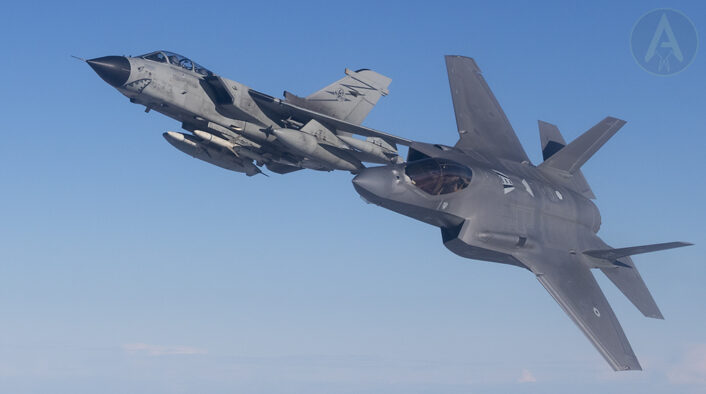50 years ago, the Panavia Tornado took to the skies for the first time, inaugurating a long, action-packed and impressive career, including 42 years of service with the Italian Aeronautica Militare.
On Aug. 14, 1974 the Panavia Tornado had its first flight at the hands of pilot Paul Millett, starting an eventful career that would see the Tonka, as the Tornado is affectionately called in Britain as a reference to old Tonka toy trucks, get involved in various conflicts and serve in four different Air Forces.
Italy was a founding partner of the Panavia Aircraft Gmbh consortium, building the Tornado through the 15% stake of Aeritalia (now Leonardo), and was deeply involved in the development and production process along with the British BAE Systems and the German Messerschmitt-Bölkow-Blohm (now part of Airbus).
The first Italian prototype had its first flight on Dec. 5, 1975 from Torino Caselle, while the first production airframes intended for the Italian Aeronautica Militare came off the assembly line only in 1981, and on Aug. 27, 1982 the first operational aircraft finally landed at Ghedi air base, their main home for the next 42 years.
Over the course of their career, the Italian Air Force would come to use 123 Tornado airframes (without including the two prototypes and a pre-production aircraft) from all the variants of the plane: IDS (strike), ECR (electronic warfare) and ADV (air defense).
Italian Tornados during the Cold War
Except for 2 IDS prototypes and a single pre-production airframe, the Italian Airforce received a total of 99 IDS (InterDictor/Strike) planes, divided between 82 standard variants and 17 training airplanes with flight controls in both cockpits, out of a grand total of 974 airframes produced for the British Royal Air Force, the German Luftwaffe, the Italian Aeronautica Militare and the Saudi Al-Quwwat Al-Jawiyah Al-Malakiyah as-Su’udiyah (Royal Saudi Air Force).
All the Italian Tornado IDS aircraft were initially operated by the 6th Stormo (Wing) “Diavoli Rossi” (Red Devils) based at Ghedi air base, and armed with a panoply of weapons to strike the expected enemy in case of war, with a Soviet and Warsaw Pact attack at the Eastern border of Italy.
Luckily, the threat never materialized and the Tonkas would spend the rest of the Cold War in training.
The first airframe loss also happened during this time, when a plane flown by Captain C. Gambuti and Captain I. Ceccarelli crashed in 1984, sadly with the loss of the two crew members.
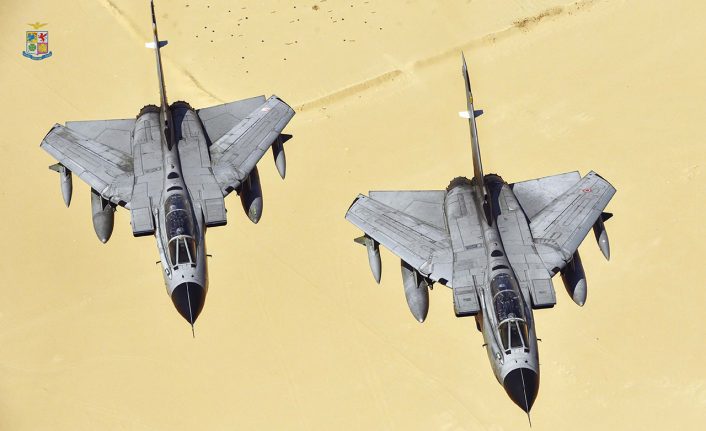
Operation Locust
The Italian Tornadoes had their first taste of combat with the Italian contribution to the International operation to liberate Kuwait from the Iraqi Invasion, codenamed Operazione Locusta (Locust). Eight Tornados (plus two spares) from the 6th, 36th and 50th Stormo (the last two Stormi having received the Tonkas from 1984 and 1990 respectively) were deployed to the Emirati Al-Dhafra Air Base, near Abu Dhabi, starting from Sept. 25, 1990 as part of Operation Desert Shield.
Then, with the start of Operation Desert Storm, Tonkas had the honor of flying the first operational combat missions of the Italian Air Force since the end of World War II. The Italian contingent successfully carried out 225 sorties for a total of 589 flight hours during Operation Desert Storm, but suffered the loss of one aircraft during the first mission in the night between Jan. 17 and 18, 1991, over occupied Kuwait.
Part of the “LEGION 15” four-ship formation, the MM7074 Tornado flown by Major Gianmarco Bellini and navigator Captain Maurizio Cocciolone, was the only plane from the Allied strike package able to refuel in the stormy night. However, the Tornado was later shot down by Iraqi ZSU-23-4 Shilka SPAAGs (Self-Propelled Anti-Air Gun) immediately after hitting its assigned target.
Having successfully ejected, both pilots were captured by the Iraqi Republican Guard and were then tortured and shown on Iraqi television in a propaganda video- They were released only after 47 days of captivity and the end of the Gulf War. You can read the whole detailed story of that ill-fated Tonka and its pilots in this story we published here at The Aviationist for the 30th anniversary.
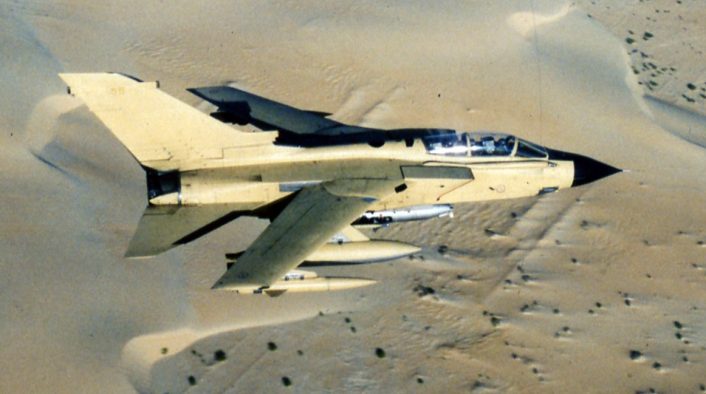
Back to Italy and the Balkans
The rest of the 90s were equally packed with action for the Italian Tonkas, as the dissolution of Yugoslavia and the Jugoslav War that followed required frequent intervention by NATO and the International Community, in order to stop violence and ethnic cleansing in the region.
The Italian Air Force converted 15 Tornado IDS aircraft into the ECR (Electronic Combat / Reconnaissance) variant, devoted to SEAD (Suppression of Enemy Air Defenses) missions and armed with the AGM-88 HARM anti-radiation missile. Assigned to the 50th Stormo “Giorgio Graffer” based at the Piacenza-San Damiano air base, the Tornados ECR between 1993 and 1999 participated in various NATO operations, including Operation Sharp Guard, Joint Guardian, Joint Forge, Decisive Endeavour and Allied Force.
During the latter, ECR pilots of the 50th Stormo took part in 176 missions and launched 115 HARM missiles in combat against Serbian radar positions. Over the course of the campaign, Italian Tonka pilots recorded another first for the Aeronautica Militare, using for the first time Night Vision Goggles (NVG).
Between 1995 and 2004 Italy also operated an additional 24 Tornado aircraft on lease from the Royal Air Force. These were of the ADV (Air Defence Variant, also known as Tornado F.2 and F.3 in the RAF) type, a result of a British requirement to replace their old Lightning and Phantom II fighters and born after the refusal to buy F-15 Eagle or discounted F-14 Tomcat (as these were planes built for Iran and never delivered due to the onset of the Islamic Revolution) American fighters.
Operated by the 36th Stormo “Riccardo Hellmuth Seidl” based at Gioia del Colle, near Bari, and the 53rd Stormo “Guglielmo Chiarini” out of the Natale e Silvio Palli Airport of Cameri, Piedmont, the planes were leased for ten years, similarly to the American F-16 Falcons of the Peace Ceasar program, as a stop-gap measure between the progressive retirement of the F-104 “Starfighter” and the introduction of the first squadrons of Eurofighter Typhoon (expected by 2010).
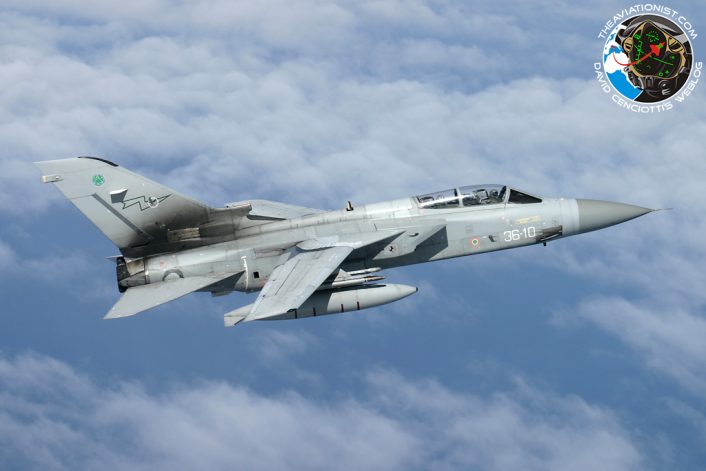
Libya and the Middle East
The new millennium saw the Panavia Tornados of the Aeronautica Militare again play an active role in numerous crisis, while at the same time receiving important upgrades and new weapons.
Since 2009, Italian Tornados were equipped with the advanced Rafael Reccelite II ISR pod, able to collect images in all directions from high, medium and low altitudes, and to broadcast live video imagery via datalink to ground stations and to receivers in a range of about 100 miles. This pod was first employed when Tornados carried out ISR missions in Afghanistan from November 2008 to December 2009.
The aircraft, deployed to Mazar-i-Sharif to support ISAF with recce missions, were often tasked with discovering opium poppy farms and depots across the country. Interestingly, few years later a Tornado played a similar role over Italy, helping police forces locate a marijuana plantation.
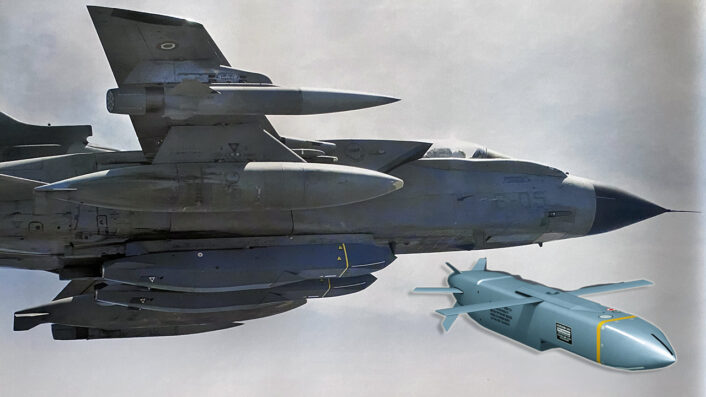
While the first decade of the century was mostly peaceful and devoted to training, the eruption of a civil war in 2011 in Libya, close to the Sicilian shores, and the subsequent NATO intervention brought the Tornado to the frontlines. Over the course of the campaign, the Italian Tornado IDS, Tornado ECR and the Italian-Brazilian AMX light attack plane released 313 laser-guided bombs and 345 GPS-guided JDAMs, along with 25 new Storm Shadow stealth cruise missiles, the latter a new addition to the weapons available for the Tonkas after the MLU upgrades from 2005.
The eruption of the terrorist insurgency of Daesh (or ISIS) in Iraq and Syria again brought again the Tonkas to combat, with the Tornados IDS of 6th Stormo deployed to Ahmed Al Jaber Airbase in Kuwait.
During the first tour in support of Operation Inherent Resolve from 2014 to 2016, the Tonkas logged over 3,000 flight hours on about 2,000 targets, but on their second tour from 2020, in just six months collected imagery of 5,000 targets during 4,000 flight hours.
A tragic crash during a training flight near the Italian city of Ascoli Piceno marred a period distinguished by a great safety record for the aircraft. On Aug. 19, 2014, two Tornados IDS, callsign Freccia 21 (MM7009) and callsign Freccia 11 (MM7087) collided mid-air, with the loss of the four crew members onboard (Captain Mariangela Valentini and Captain Piero Paolo Franzese on Freccia 21, Captain Alessandro Dotto and Captain Giuseppe Palminteri on Freccia 11).
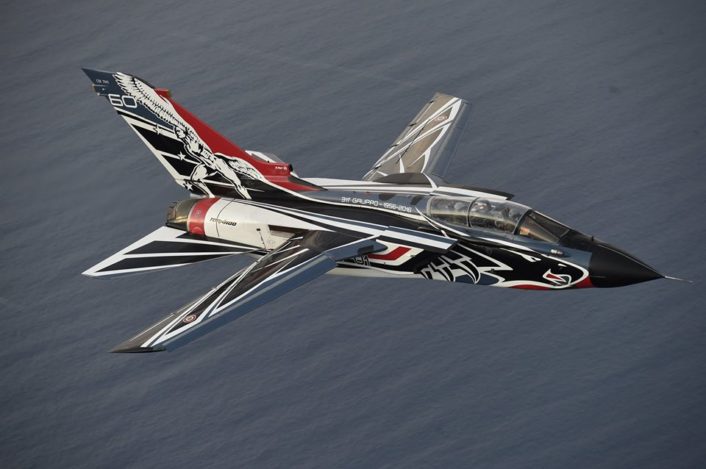
The future and retirement
Having played an important and active part throughout their long career, after 42 years of service the Tonkas are nearing the time of retirement. The Italian Air Force, according to the World Air Forces 2024 report, still has 33 IDS (of which 5 trainers) and 13 ECR airframes available, but the Tonkas, along with the AMX, are slated to be soon replaced by the F-35 Lightning II stealth multirole fighter.
The Tornado flightline of the Italian Air Force in the meantime has been restructured, with all the Tonkas consolidated in the 6th Stormo of Ghedi, with the 154th Gruppo “Diavoli Rossi” on the IDS and the 155th Gruppo ETS (Electronic Warfare Tactical Suppression) “Pantere Nere” flying the ECR. While they await their replacements, Tonkas are still pleasing fans and onlookers with impressive special liveries, some expressly created to celebrate the milestone of 50 years from the first flight.
The America Spangdahlem Air Base in Germany has also recently hosted a special celebration to mark the 50th anniversary of both the Tornado and the F-16 Fighting Falcon. The celebration included a flyover by two F-16s of the U.S. Air Force 480th Fighter Squadron, a Tornado IDS of the German Air Force Taktisches Luftwaffengeschwader 33 (awaiting their F-35 replacements as well) and a Tornado ECR of the Italian Air Force 155th Gruppo ETS.
